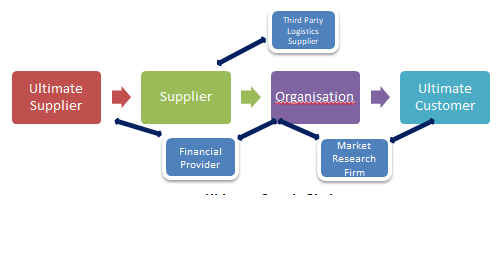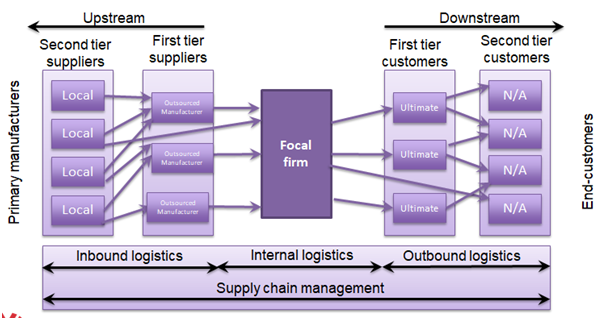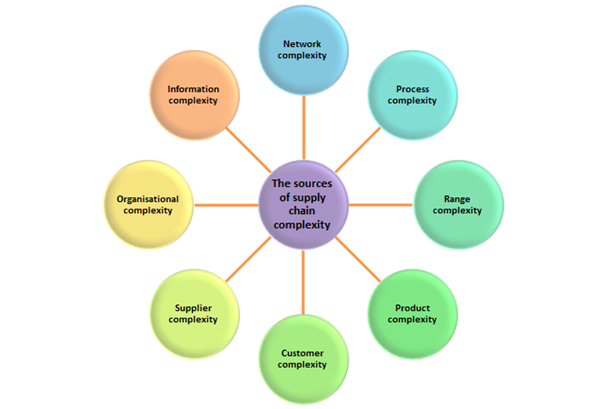Supply Chain Management Assignment Identifying Transformation Opportunities for M&S
Question
Task:
Purpose
In this supply chain management assignment, you will have the opportunity to develop a supply chain transformation plan to prepare your organisation for overcoming those challenges and competing through its supply chain.
Requirements
The required word length for this assessment is 2,500 words (plus 10% tolerance without penalty).
In terms of structure, presentation and style, you are required to follow the AIB's standard report format. In the body of your report, refer to and provide relevant examples from the supply chain of your organisation (or the organisation that you are familiar with) to address the following:
Provide a brief overview of the organisation and its supply chain and draw a high-level supply network map.
•Provide relevant contextual information about the organisation and its supply chain
•Visualise the structure of supply chain using a “supply network” diagram
Critically analyse the complexity of the supply chain.
Given the challenges that you identified in the era of supply chain competition in your first assessment and your analysis of the supply chain complexity, identify opportunities to transform your supply chain to ensure it delivers customer value and strengthens your organisation’s competitive position.
Provide two key recommendations for transforming your supply chain from the above analysis and discuss how each recommendation can be successfully implemented.
Answer
1. Introduction
The major focus of supply chain management assignmentis to discuss how supply chain interaction and management is an extremely pivotal element for a company which is present in the retail sector. For the brand of M&S this is one of the key factors which influence its business and the profitability of the same. The company has a vast and wide spread market share which allows it to generate capacities which its competitors may not be able to. However, distinctively large supply chains indicate discreet issues which may be present in the portfolio of a brand. Thus, for M&S this is important to be understood and tackled. This ensures that for the overall element of the same there is a need for identifying the factor of essentiality and importance which the brand needs to place on its current systems.
This report looks into the company supply chain of M&S as a brand and seeks to outline the different complexities which are present. The report also identifies the core transformation opportunities for the brand and accordingly recommends solutions. This is pivotal to the profit of M&S and its survivability in the market as a consequence of the COVID-19 pandemic and the market disruptions due to the advent of the same. 2. Background and Supply network map

Figure 1: M&S Supply Network Diagram
(Source: Created by Author)
In terms of the supply network diagram it can be understood that the company of M&S uses a different strategy for its overall systems. In terms of the supply chain of the brand, the organization takes care of multiplication, activities and leaves the souring to selective suppliers only. It can be understood that the involvement of the firm in this process and system is very high with a large level of oversight into the matter. As per the study of Wieland (2021), any brand which has a large oversight into supplier activities is a responsible brand which takes on concurrent factors and uses proper sustainability methods.
First it can be assessed that the company overall sees through the element of having suppliers which are bifurcated. The company has local supply and then major suppliers. The major suppliers take raw materials from the local supplies and then provide it to M&S directly. Three suppliers are selected by the company itself. The supply chain of M&S depends on the ase of these suppliers and their sourcing as well. It can be viewed that the company gets its manufacturing outsourced and these are M&S’s first tier suppliers. Local raw material producers are on the second tier. Hoover, company involvement is very high in these areas.

Figure 2: Supply Network Extended
(Source: Created by Author)
Drawing from the extended supply network diagram it can be understood that M&S goes to retail itself and as a result has no first and second tier customers. The company provides goods to the ultimate customer in itself. Thus, the brand point interaction is very direct and creates a close communicational channel with the customers of the brand. Saberiet al. (2019), incidents that a direct approach is very suitable for markets as this keeps personalised efforts for the customers. This helps to assure a larger rate and level of effectiveness which can be employed and engaged within through the potential of the brand. Adding to this, it can be analysed that the rand has a longer inbound logistics chain than an outbound chain. Thus, if gathered that M&S uses lea methodologies it needs to be understood that only M&S can successfully implement these. However, in its supply chains, implementation may not be great due to lack of resource availability than access for other suppliers in third world countries with slower technological growth.
3. Supply Chain Complexity Analysis

Figure 3: Supply Chain Complexity areas
(Source: Created by author)
In this specific area for M&S it can be understood that the company essentially needs to be able to generate a large potential through the means of understanding the resounding complexities in its current supply chain. The factors which have been understood are five major areas of complexity for this business: process complexity, supplier complexity, range complexity, organisational and product complexity.
3.1 Process Complexity
In terms of the complexity which the band faces in the overall process it is easy to determine that the process is incoherent. It needs to be delineated that M&S involves a process which is lean at the epicentre of the flow of materials. However, the lack of uniformity in the case of the system leads to unnecessary time-lags which the company faces. The lack of streamlining the process leads to mismatch of supply on the inbound and outbound ends of logistics (Arditoet al. 2021). This implies that the company is essentially unable to render its resources and execute the delivery properly at a go.
3.2 Supplier Complexity
The complexity of the suppliers is that the brand is unable to generate good supply options through a range of sources which are technologically advanced. Ben-Daya (2018) indicates that technology updates in the manufacturing and supply processes are very important. Even though the company has a globally diversified base of suppliers, the supplier autonomy and lack of technology upgrades leaves the company in trouble due to delays in the inbound logistics of the firm. This affects the performance and delivery items of the company as the lean side is implemented in outbound logistics while there is no lean management on the supply side. The onus of control is also not on the brand due to this element absolutely.
3.3 Range complexity
The range for the company is heavily complex. As seen for the company and its functional aspects the company indulges in switching up its products to meet market demand. However this creates added pressure onto the case of the company effectively and also indulges in a lack of proper guidance which can be brought around and generated. It creates a system loop for the company where the orders are heavier than the supply potential and forces the brand suppliers to change at an unrequited level pace (Sodhi and Tang, 2021). This affects the quality of the product and also the delivery time of the same.
3.4 Organizational Complexity
The organizational complexity for the brand of M& is that the brand essentially contributes to a larger impact rate when it comes to the delivery of effective rates of products. It can be seen from the case of M&S that the brand indulges in heavy oversight into the target market which it has as well as the target suppliers. However, it still leaves autonomy with the suppliers itself (Nguyen et al. 2018). This implies that the band is unable to actually control the outcome of supply, but water resources behind the same. This handicaps the band in terms of the overall market within which it is functional.
3.5 Product Complexity
Products for M&S are complex due to the nature and the changes in the designs which are so frequent.it can be understood that the constant change lead to a lack of uniformity in production and the products of the brand. This not only creates customer expectations, but also delivers extreme pressure onto the manufacturers. Thus, the end result is low quality which does not build the customer expectation due to brand value and this deteriorates the bands current level of provision of products.
4. Supply Chain transformation opportunities
In terms of the supply chain, it can be understood that there is a wide range of opportunities which are available for the transformation of the same. The distinctive areas need to be addressed for ensuring that M&S can turn around the current cycle which creates the major issue for the brand and effectively implement a routing quality output which can be actualised through its brand potential. This would also ensure that M&S brings in stratification and integration to enhance its market growth and gain competitive advantages with the customer demographic of the market.
4.1 Control and oversight
The control and oversight of the supply chain is important and the first area of transformation which can be brought around. It needs to be understood that M&S,as it has a centralised structure for its organisational outbound logistics, needs to integrate this with the overall element of the outsourced methods as well. The company needs to ensure that oversight into its supply operations is maintained to the largest possible extent and this would help the brand to grow. Kshetri (2018), indicates that a proper control of the supply chain helps it risk assessment and theta disruption as fast as possible. This helps to generate a larger rate of impact which can be brought around and engaged within. It also implies that the supply chain be used for the development of potential which can be accessed and rendered for brand governance and quality assurance.
4.2 Integration of the supply chain
The integration of the supply chain essentially indicates that there is an effective quality of control and potency which can be derived. Koberg and Longoni (2019), indicates that the integration of the supply chain is important to streamline processes. It can be understood that for M&S as a brand it is important to bring together the supply chain. It is very important as this helps for generation of a larger element of growth and feasibility. This will help the company to ensure that there is one process which can outline the supply chain and there are no two parts of it. This helps to cover the entire process of sourcing to delivery as one singular line of action which enables the company to engage in better development of service and products as well. Reduction of jargon in the process allows for greater process efficiency and this develops a potential for M&S to ensure that the brand is able to generate a resounding level of control and integrated effort for customer satisfaction.
4.3 Range integration
Rang complexities affect businesses adversely in terms of their target markets. It can be understood that for a brand the complexity of its range indicates that the business has to create a larger amount of output into the market. As per the study of Tseng et al. (2019), it is important to understand that when a brand has different products the production is very verified. For the current situation of M&S this is not a good strategy as the business is unable to cope with it. The supplier end of the business is unable to cope and thus, the products need to be streamlined according to supplier capabilities in the case of the market. It can be understood that this would create a larger level of impact which can be drawn out and brought around for a company such as that of M&S. It would significantly help the company to mitigate its risks in terms of the overall market scope and reduce the oversight which is brought into the supply resources (Asamoahet al. 2021). This would free up potential for better management and efficiency and also help to cut loss.
Thus it can be understood that addressing these three areas would be beneficial for M&S as a brand to generate market leverage and return as one of the best brands in the market. The next section of this report indicates the different pathways which can be undertaken by M&S to achieve this end goal in terms of the market.
5. Recommendations
5.1 Alternative 1: Buying in suppliers
The company can buy in the first tier suppliers of the firm in order to ensure that the manufacturing process is streamlined. Alternatively it can buy in both the first and second tier supplier in the countries where it can to ensure that the brand has stratified chain of command. Additionally, it can keep the oversight but impose company mandatory pixies and upgrades which are required to be made by the supplier of the brand. This creates more supplier leverage for the brand and also gives a direct channel of influence to the supply net. This helps the company to act upon the existing oversight which it already has and streamline all the systems to make them lean systems effectively.
5.2 Alternative 2: Funding Suppliers
The funding of market supply will lead the company to ensure that the supplier are fitted with the best technological requirements a r market demands This will gin help the brand tostratifyits approach. Maintaining a certain amount of oversight onto the sustainability, provision of investments helps the brain to generate greater supplier loyalty, and it also engages the suppliers to ensure that they can provide the brand with better products in shorter run cycles. This helps the brain and the applied side of the equation to come to terms and helps the inbound outbound logistics to function immaculately.
5.3 Alternative 3: Reducing product variation
The product variation of the company essentially would help the brand to generate greater and more possible outcomes in terms of its suppliers. It can be understood that the band can maintain and uphold its effective capacity to generate a larger range and scale of productivity which can be incorporated within the current element of branding and potential. It helps the brand to ensure and engage in a larger rate for productive development for the supply side and this helps inbound logistic pressure relief. This would help to bring about a balance between the brand expectations and the supplier provision. It would also lead to gaining a competitive edge in the market as the brand value attached to the products of the band will be fixed and the brand will be able to provide consistency in the market.
Any of these three strategies will benefit the business of M&S to ensure that it is able to develop a key acidity in providing value to its customers through its supply network.
6. Conclusion
Derivations of this study indicate and imply that the company of M&S will be able to generate greater conscious potential for the band through the means of effective rate of implacability and action which can be undertaken. This helps in assuring that the company will be able to leverage its current market position to create advantages which are competitive in nature. Adding to this, it can be analysed through this report that the band already has falters in its current supply chain, and the best way to use these and turn themaroundis to integrate and stratify its supply chain approach in terms of the market.
Relief of pressure on suppliers and the organisational employees will work to reduce turnover rates. This in-turn has the potential to impact costs for the company. It will help the company to generate a large level of market potential approach which can be undertaken and assured to the largest possible extent. This helps in engagement of better services and propensity to develop a resounding level of potential. It also impacts the company in a way which allow the brand to generate a significant output in terms of the market. ?
Reference List
Ardito, L., Petruzzelli, A.M., Panniello, U. and Garavelli, A.C., 2019. Towards Industry 4.0: Mapping digital technologies for supply chain management-marketing integration. Business Process Management Journal.
Asamoah, D., Agyei-Owusu, B., Andoh-Baidoo, F.K. and Ayaburi, E., 2021. Inter-organizational systems use and supply chain performance: Mediating role of supply chain management capabilities. International journal of information management, 58, p.102195.
Ben-Daya, M., Hassini, E. and Bahroun, Z., 2019. Internet of things and supply chain management: a literature review. International Journal of Production Research, 57(15-16), pp.4719-4742.
Koberg, E. and Longoni, A., 2019. A systematic review of sustainable supply chain management in global supply chains. Journal of cleaner production, 207, pp.1084-1098. Kshetri, N., 2018. 1 Blockchain’s roles in meeting key supply chain management objectives. International Journal of Information Management, 39, pp.80-89.
Nguyen, T., Li, Z.H.O.U., Spiegler, V., Ieromonachou, P. and Lin, Y., 2018. Big data analytics in supply chain management: A state-of-the-art literature review. Computers & Operations Research, 98, pp.254-264.
Saberi, S., Kouhizadeh, M., Sarkis, J. and Shen, L., 2019.Blockchain technology and its relationships to sustainable supply chain management.Supply chain management assignment International Journal of Production Research, 57(7), pp.2117-2135.
Sodhi, M.S. and Tang, C.S., 2021. Supply chain management for extreme conditions: Research opportunities. Journal of Supply Chain Management, 57(1), pp.7-16.
Tseng, M.L., Islam, M.S., Karia, N., Fauzi, F.A. and Afrin, S., 2019. A literature review on green supply chain management: Trends and future challenges. Resources, Conservation and Recycling, 141, pp.145-162.
Wieland, A., 2021. Dancing the supply chain: Toward transformative supply chain management. Journal of Supply Chain Management, 57(1), pp.58-73.












